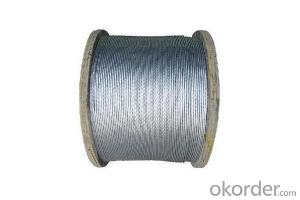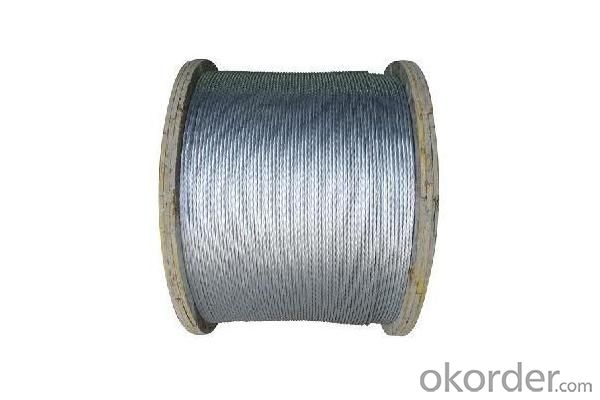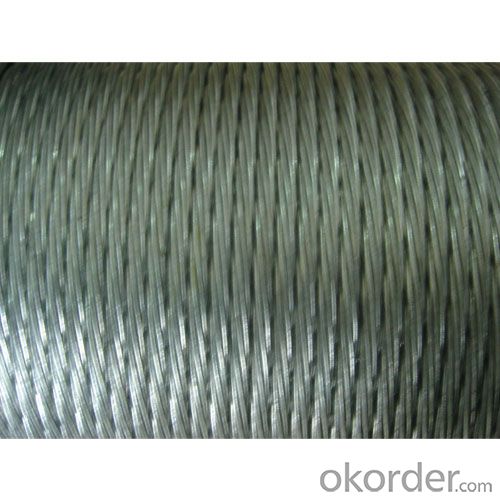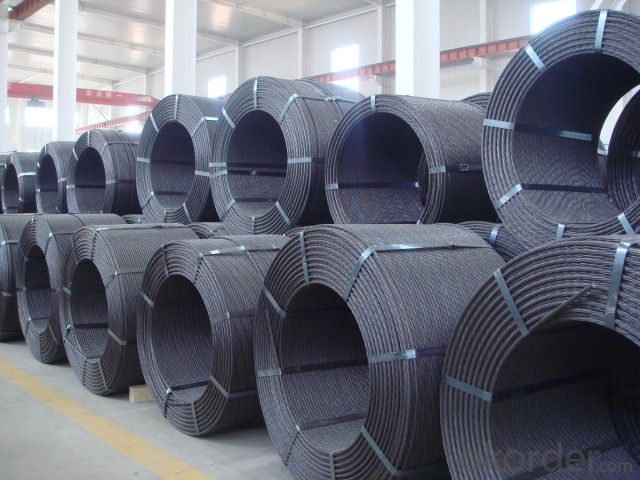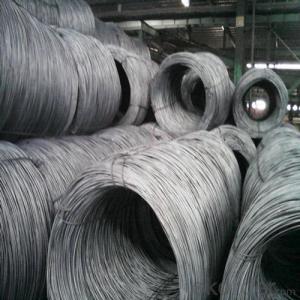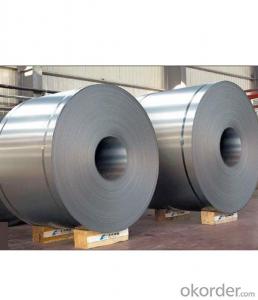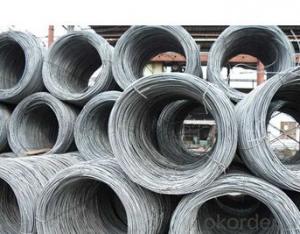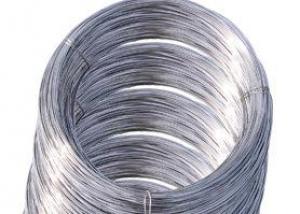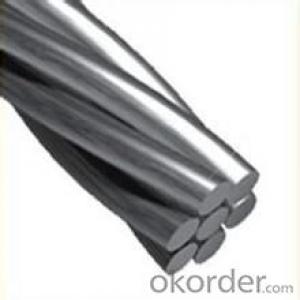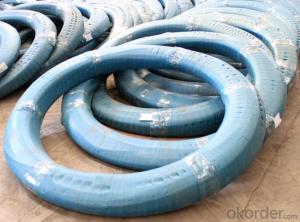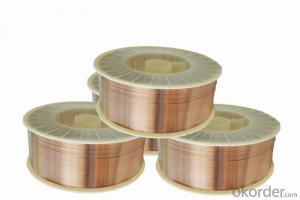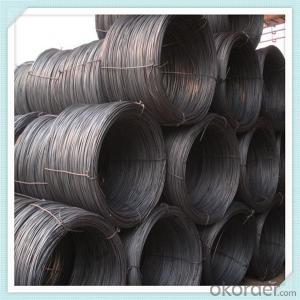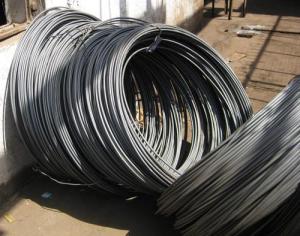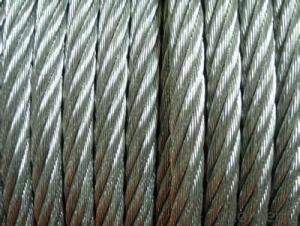Wholesale Products China inner wedges for 0.6" pc strand
- Loading Port:
- Tianjin
- Payment Terms:
- TT OR LC
- Min Order Qty:
- 50 m.t.
- Supply Capability:
- 50000 m.t./month
OKorder Service Pledge
OKorder Financial Service
You Might Also Like
Quick Details
Steel Grade: High carton steel wire 82B
Standard: BS
Wire Gauge: 1*7 - 15.2mm
Place of Origin: Tianjin, China (Mainland)
Type: Drawn Wire
Application: Construction
Alloy Or Not: Non-alloy
Special Use: Cold Heading Steel
Model Number: 1*7-15.2mm
- Commodity: Prestressed Concrete Steel Strand
Strand diameter: 15.2mm
Steel area: 143.4㎡
Unit mass: 1126kg/km
Lay Direction: Left
low relaxation: 3.5%1000h
at Yield strength (1%Ex): 234.6KN
Breaking strength: 260.7KN
Elongation in(Lo>24''/610m: 5.0
Modulus of elasticity: 199
Packaging & Delivery
| Packaging Details: | Packing: In soft coils, water proof paper inner, white color hessian (or. P.P) cloth outer Coil Weight: around 2.500 kg or negotiation Cargo: to be stuffed in 25*20GP containers (No more than 25MTS / container) |
|---|---|
| Delivery Detail: | 20 days after confirm the order |
| Wholesale Products China inner wedges for 0.6" pc strand |
Product Pictures of inner wedges for 0.6" pc strand
- Q: What are the common packaging options for steel wire rod?
- The common packaging options for steel wire rod include coils, bundles, and wooden or steel pallets.
- Q: What are the different types of steel wire rod available?
- Steel wire rods come in various types, each possessing its own distinctive properties and applications. Some commonly used types include carbon steel wire rods, alloy steel wire rods, stainless steel wire rods, and galvanized steel wire rods. Carbon steel wire rods are widely utilized due to their exceptional strength and durability. They find extensive use in construction, automotive, and manufacturing sectors for reinforcing concrete, creating wire mesh, and producing springs and fasteners. Alloy steel wire rods are fortified with additional elements like chromium, nickel, or molybdenum, which enhance their strength, hardness, and corrosion resistance. These rods are commonly employed in the production of high-strength wires, cables, and springs that require optimal performance under demanding conditions. Stainless steel wire rods exhibit remarkable corrosion resistance, as well as excellent strength and heat resistance properties. They are frequently employed in applications where hygiene, durability, and aesthetics are crucial, such as the production of kitchen utensils, medical instruments, and architectural structures. Galvanized steel wire rods are coated with a layer of zinc to provide enhanced corrosion resistance. This type of wire rod is commonly employed in outdoor and marine applications, including fencing, electrical wiring, and fishnets, where exposure to moisture and harsh environments is a concern. Apart from these types, there are also specialty steel wire rods available, such as oil-tempered wire rods used in the production of automotive suspension springs, and cold-heading quality wire rods used for manufacturing fasteners and screws. In conclusion, the availability of various types of steel wire rods caters to a wide range of applications across different industries. These wire rods offer strength, durability, and corrosion resistance tailored to specific needs.
- Q: What are the common welding techniques used for steel wire rod?
- The common welding techniques used for steel wire rod include gas metal arc welding (GMAW), shielded metal arc welding (SMAW), and resistance welding.
- Q: How is steel wire rod used in the manufacturing of wire for cable harnesses?
- Steel wire rod is used in the manufacturing of wire for cable harnesses as it provides the necessary strength and durability required for the cables. The wire rod is first drawn through a series of dies to reduce its diameter and increase its length. This process, known as wire drawing, results in a fine and smooth wire that can be easily bent and shaped without breaking. The wire is then further processed and insulated to meet the specific requirements of cable harnesses, such as conducting electricity, transmitting signals, or supporting heavy loads. Overall, steel wire rod is a crucial component in the production of wire for cable harnesses, ensuring their reliability and performance.
- Q: What are the different impact testing methods for steel wire rod?
- There are several different impact testing methods that can be used to assess the mechanical properties of steel wire rods. These methods help determine how well the wire rods can withstand sudden impact or shock loading, which is crucial in various applications such as construction, automotive, and aerospace industries. Some of the commonly used impact testing methods for steel wire rods include: 1. Charpy Impact Test: This method involves striking a notched or V-notch specimen with a pendulum hammer to measure the energy absorbed during fracture. The test measures the toughness of the material and is widely used due to its simplicity and ease of implementation. The results are typically reported as the energy absorbed in joules. 2. Izod Impact Test: Similar to the Charpy test, the Izod test also measures the energy absorbed during fracture. However, in this method, the specimen is clamped vertically, and the pendulum strikes it at the opposite side of the notch. The test provides information about the material's resistance to sudden impact. 3. Drop Weight Test: In this method, a weight is dropped from a specified height onto a wire rod specimen. The energy absorbed during fracture is measured, and the test is useful in determining the material's ability to withstand impact loading under specific conditions. 4. Dynamic Tear Test: This test evaluates the fracture toughness of steel wire rods by measuring the energy required to propagate a pre-existing crack through the specimen. The test involves applying a load to the specimen, either by a pendulum or a hydraulic system, and monitoring the crack propagation. 5. Ballistic Pendulum Test: This method determines the velocity of a small projectile before and after striking the wire rod specimen. By measuring the change in velocity, the impact resistance of the material can be evaluated. The test is commonly used for high-strength steel wire rods. Each of these impact testing methods has its own advantages and limitations, and the choice of the method depends on various factors such as the specific application, material properties, and test requirements. It is essential to select an appropriate testing method that accurately reflects the intended use of the steel wire rod and ensures its performance and reliability in real-world scenarios.
- Q: How is steel wire rod tested for resistance to pitting corrosion?
- Steel wire rod is tested for resistance to pitting corrosion through various methods such as electrochemical testing, salt spray testing, and exposure to corrosive environments. These tests evaluate the rod's ability to withstand pitting corrosion by measuring factors like its corrosion potential, corrosion rate, and appearance of pits or localized corrosion. Additionally, microscopic examination and surface analysis techniques may be used to further assess the rod's resistance to pitting corrosion.
- Q: How is steel wire rod priced in the market?
- Steel wire rod is typically priced in the market based on various factors such as global supply and demand, production costs, raw material prices, and market competition. Additionally, factors like quality, size, and delivery requirements also influence the pricing of steel wire rod. Overall, it is a dynamic process where market forces play a significant role in determining the price of steel wire rod.
- Q: What are the common storage methods for steel wire rod?
- The common storage methods for steel wire rods include stacking them horizontally on pallets, using steel racks or shelves to store them vertically, or bundling and tying them together to hang from overhead racks or hooks.
- Q: How is steel wire rod used in the manufacturing of wire for wind turbines?
- Steel wire rod is a crucial component in the manufacturing of wire for wind turbines as it forms the base material for making the wire. The wire rod is first processed through various stages, including drawing and annealing, to enhance its strength and flexibility. Once the wire is formed, it is utilized in wind turbine applications, such as the construction of electrical windings, cables, and structural components. The high tensile strength of steel wire rod ensures that the wire can withstand the demanding conditions within wind turbines, contributing to their overall efficiency and reliability.
- Q: How is steel wire rod used in the manufacturing of wire harness assemblies?
- Wire harness assemblies rely on steel wire rod as an essential component in their manufacturing process. These assemblies, which serve to transmit electrical signals and power in industries like automotive, aerospace, and telecommunications, consist of intricate systems of wires, cables, and connectors. To manufacture these wire harness assemblies, steel wire rod is typically employed as the raw material. It undergoes processing and drawing to create thin, flexible wires of varying gauges and diameters. These wires are then coated or insulated with materials like PVC, nylon, or Teflon to provide protection against abrasion, heat, and moisture while also ensuring electrical insulation. The use of steel wire rod in wire harness assemblies offers numerous advantages. Firstly, steel is a strong and durable material that provides the necessary strength and structural integrity to the wires. This ensures that the wire harness assembly can withstand the challenges posed by its intended application and environment. Furthermore, steel wire rod boasts excellent electrical conductivity properties, enabling efficient transmission of electrical signals and power through the wires. This is particularly important in applications requiring high-quality signal transmission, such as automotive electrical systems or telecommunications infrastructure. Additionally, the flexibility of steel wire rod facilitates easy bending and shaping during the manufacturing process. This is crucial for creating complex wire harness assemblies that can fit into tight spaces or follow specific routes within a device or equipment. In summary, steel wire rod plays a crucial role in the manufacturing of wire harness assemblies by providing strength, electrical conductivity, and flexibility. Its utilization ensures the reliability and performance of wire harnesses in various industries, contributing to the smooth functioning of electrical systems.
Send your message to us
Wholesale Products China inner wedges for 0.6" pc strand
- Loading Port:
- Tianjin
- Payment Terms:
- TT OR LC
- Min Order Qty:
- 50 m.t.
- Supply Capability:
- 50000 m.t./month
OKorder Service Pledge
OKorder Financial Service
Similar products
Hot products
Hot Searches
Related keywords
